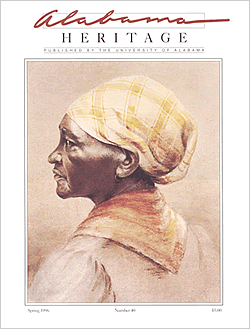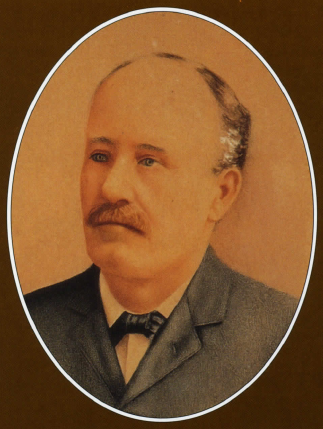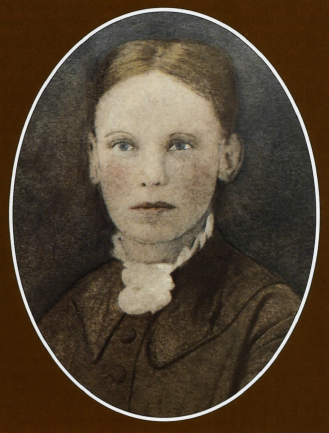|
On the cover: Frances Bell, an ex-slave, was a favorite subject of a Huntsville artist Maria Howard Weeden, who turned to painting to supplement the family's meager income after the Civil War. (Courtesy Burritt Museum, Huntsville)
|
FEATURE ABSTRACTS
To Teach the Negro
By Judith Hillman Paterson
In 1878 a young, self-educated Scottish immigrant arrived in Marion, Alabama, to assume the reins at Alabama's first state-assisted black institution of higher learning, the American Missionary Association's Abraham Lincoln School. With his wife, Maggie, William Burns Paterson spent the next ten years nurturing a remarkable institution while often facing racially motivated hostilities. In 1887 following an act of arson, the state legislature voted to move the school -- then called the Alabama State Normal School for Colored Students -- to Montgomery, where the Patersons worked to maintain a balance of liberal arts education along with industrial training. In 1969 the school became Alabama State University, attaining university status almost one hundred years after its creation at Marion.
Additional Information
About the Author
Judith Paterson--author, journalist, and educator--grew up in Montgomery, Alabama, and received her Ph.D. from Auburn University. She taught English literature at Auburn at Montgomery for eight years before joining the faculty at the University of Maryland, where she is currently an associate professor in the College of Journalism.
Author of four books, Paterson has written on Thomas More, Philip Roth, and pioneering women's rights activist
Marguerite Rawalt. Her most recent work, Sweet Mystery: A Book of Remembering (Farrar, Straus, & Giroux, I996), recounts Professor Paterson's childhood up to the time of her mother's death (when Paterson was nine years old). Paterson hopes her book will interest "people from parts of the country who don't know that life is very mixed up in the South."
By Judith Hillman Paterson
In 1878 a young, self-educated Scottish immigrant arrived in Marion, Alabama, to assume the reins at Alabama's first state-assisted black institution of higher learning, the American Missionary Association's Abraham Lincoln School. With his wife, Maggie, William Burns Paterson spent the next ten years nurturing a remarkable institution while often facing racially motivated hostilities. In 1887 following an act of arson, the state legislature voted to move the school -- then called the Alabama State Normal School for Colored Students -- to Montgomery, where the Patersons worked to maintain a balance of liberal arts education along with industrial training. In 1969 the school became Alabama State University, attaining university status almost one hundred years after its creation at Marion.
Additional Information
- Richardson, Joe Martin. Christian Reconstruction: The American Missionary Association and Southern Blacks, 1861-1890. (University of Georgia Press, 1986).
- Sherer. Robert G. Subordination or Liberation? The Development and Conflicting Theories of Black Education in Nineteenth Century Alabama. (University of Alabama Press, 1977).
- _______ , "William Burns Paterson: 'Pioneer as Well as Apostle of Negro Education in Alabama."' Alabama Historical Quarterly 36 (Summer 1974): 121-50.
- Lincoln School
- Lincoln Normal School (image)
- Public Education During the Civil War and Reconstruction
About the Author
Judith Paterson--author, journalist, and educator--grew up in Montgomery, Alabama, and received her Ph.D. from Auburn University. She taught English literature at Auburn at Montgomery for eight years before joining the faculty at the University of Maryland, where she is currently an associate professor in the College of Journalism.
Author of four books, Paterson has written on Thomas More, Philip Roth, and pioneering women's rights activist
Marguerite Rawalt. Her most recent work, Sweet Mystery: A Book of Remembering (Farrar, Straus, & Giroux, I996), recounts Professor Paterson's childhood up to the time of her mother's death (when Paterson was nine years old). Paterson hopes her book will interest "people from parts of the country who don't know that life is very mixed up in the South."
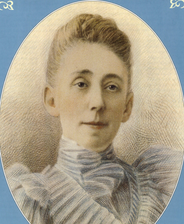 Maria Howard Weeden (1846-1905), struggling to survive after the Civil War, turned to painting to supplement the family's meager income. Many of her subjects were ex-slaves whom she knew in Huntsville. (Courtsey Huntsville-Madison County Public Library)
Maria Howard Weeden (1846-1905), struggling to survive after the Civil War, turned to painting to supplement the family's meager income. Many of her subjects were ex-slaves whom she knew in Huntsville. (Courtsey Huntsville-Madison County Public Library)
The Art of Howard Weeden
By Kay Cornelius
Nineteenth-century artist Maria Howard Weeden could have been just another maiden lady who used her talent to eke out a living after the Civil War. Like many Southerners of her day, Weeden found her comfortable life of only a few years earlier gone forever. Faced with the prospect of financial ruin, she determined to use her talent to supplement her family's meager income. Weeden's portraits of former slaves departed from the comic "minstrel" representations of her contemporaries, however, conveying great strength and dignity. Showings of Weeden's work in Berlin and Paris brought her international acclaim. In 1899 Joel Chandler Harris, the creator of "Uncle Remus," described Weeden's portraits as "powerful" and "charged with feeling." Now, almost one hundred years later, Cornelius's generously illustrated article lets us see for ourselves just what he meant.
Additional Information
Maria Howard Weeden - AL Women's Hall of Fame
For more information on Howard Weeden, see:
About the Author
Historical novelist Kay Cornelius has been a volunteer docent at Huntsville's Weeden House since 1990. She notes that Gen. Ormsby M. Mitchel, the subject of her first article for Alabama Heritage (No. 34, Fall I994), apparently lived there during the first months of the Federal occupation of Huntsville during the Civil War.
Cornelius has authored one contemporary and six historical novels, most of which have been published by Barbour & Company. She is currently writing four historical novels for Moorings, a division of Random House. The first, Twin Willows, will be available in September 1996. Her article on Gen. William Moore--for whom Moore County, Tennessee, is named--recently appeared in Tennessee Historical Quarterly.
By Kay Cornelius
Nineteenth-century artist Maria Howard Weeden could have been just another maiden lady who used her talent to eke out a living after the Civil War. Like many Southerners of her day, Weeden found her comfortable life of only a few years earlier gone forever. Faced with the prospect of financial ruin, she determined to use her talent to supplement her family's meager income. Weeden's portraits of former slaves departed from the comic "minstrel" representations of her contemporaries, however, conveying great strength and dignity. Showings of Weeden's work in Berlin and Paris brought her international acclaim. In 1899 Joel Chandler Harris, the creator of "Uncle Remus," described Weeden's portraits as "powerful" and "charged with feeling." Now, almost one hundred years later, Cornelius's generously illustrated article lets us see for ourselves just what he meant.
Additional Information
Maria Howard Weeden - AL Women's Hall of Fame
For more information on Howard Weeden, see:
- Gamble, E P. "Howard Weeden." Library of Southern Literature Vol. 13 (1910): 5722.
- Patrick, Pamela Cowie. Maria Howard Weeden: The Gentle Artist. (Writers Consortium Books, 1989).
- Roberts, Frances C. and Sarah Huff Fisk. Shadows on the Wall: The Life and Works of Howard Weeden. (Colonial Press, 1962).
- Weeden, Maria Howard. Bandanna Ballads, with Introduction by Joel Chandler Harris (Doubleday, McClure & Co., 1899).
- _______. Songs of the Old South. (Doubleday, Page & Co., 1900).
- _______. Old Voices. (Doubleday, Page & Co., 1904).
About the Author
Historical novelist Kay Cornelius has been a volunteer docent at Huntsville's Weeden House since 1990. She notes that Gen. Ormsby M. Mitchel, the subject of her first article for Alabama Heritage (No. 34, Fall I994), apparently lived there during the first months of the Federal occupation of Huntsville during the Civil War.
Cornelius has authored one contemporary and six historical novels, most of which have been published by Barbour & Company. She is currently writing four historical novels for Moorings, a division of Random House. The first, Twin Willows, will be available in September 1996. Her article on Gen. William Moore--for whom Moore County, Tennessee, is named--recently appeared in Tennessee Historical Quarterly.
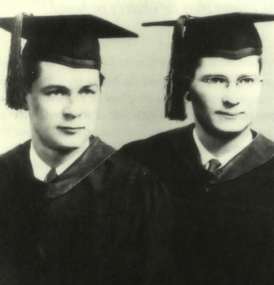 Fraternal twins Julian (left) and James Hardy both graduated from the University of Pennsylvania medical school in 1942. Julian practiced medicine in Birmingham until his death 1979. (Courtesy James D. Hardy and the University of Mississippi Medical Center)
Fraternal twins Julian (left) and James Hardy both graduated from the University of Pennsylvania medical school in 1942. Julian practiced medicine in Birmingham until his death 1979. (Courtesy James D. Hardy and the University of Mississippi Medical Center)
Alabama Heritage Profile: Dr. James D. Hardy
By J. Mack Lofton Jr.
On January 23, 1964, Dr. James D. Hardy assured himself a place in medical history when he performed the first heart transplant into a human patient. "Death was imminent," recalls Hardy. "If a heart transplant was to be done, it had to be done at once." At a time before human-donor hearts were available, Hardy and his team at the University of Mississippi chose to use the heart of a chimpanzee. "Not too many people realize that chimp genes and human genes are about 97 percent the same," says Hardy. Amid overwhelmingly negative reaction in the United States, Hardy and other U.S. transplant teams put heart transplantation on hold. Today, however, heart transplants are fairly common, and the world that once criticized him now showers Hardy with honors. (The heart used in the 1964 operation is preserved at the Smithsonian Institution.)
Additional Information
About the Author
Mack Lofton, a resident of Mountain Brook, Alabama, has published two books with the University of Alabama Press. His first, Voices from Alabama (1993), includes interviews with over 120 of the state's best storytellers, among them people from all walks of life--former sharecroppers, industrial workers, fishermen, housewives, preachers, and civil rights workers. His second book, Healing Hands: An Alabama Medical Mosaic (1995), includes interviews with doctors, nurses, midwives, and other medical personnel whose collective stories paint a portrait of health care in early twentieth-century Alabama.
Sections of this article are adapted from The World of Surgery, 1945-1985: Memoirs of One Participant, by James D. Hardy, M.D., published by The University of Pennsylvania Press in 1986. Alabama Heritage would like to thank The University of Mississippi Medical Center, particularly Janice Quinn of the Public Affairs Office, for assistance in acquiring photographs for this article.
By J. Mack Lofton Jr.
On January 23, 1964, Dr. James D. Hardy assured himself a place in medical history when he performed the first heart transplant into a human patient. "Death was imminent," recalls Hardy. "If a heart transplant was to be done, it had to be done at once." At a time before human-donor hearts were available, Hardy and his team at the University of Mississippi chose to use the heart of a chimpanzee. "Not too many people realize that chimp genes and human genes are about 97 percent the same," says Hardy. Amid overwhelmingly negative reaction in the United States, Hardy and other U.S. transplant teams put heart transplantation on hold. Today, however, heart transplants are fairly common, and the world that once criticized him now showers Hardy with honors. (The heart used in the 1964 operation is preserved at the Smithsonian Institution.)
Additional Information
- Hardy, James D., M.D., Watts R. Webb, M.D., Martin L. Dalton, Jr., M.D., and George R. Walker, Jr., M.D. "Lung Homotransplantation in Man." Journal of the American Medical Association 186 (December 21, 1963): 1065-74.
- Hardy, James D., M.D., Carlos M. Chavez, M.D., Fred D. Kurrus, M.D.,William A. Neely, M.D., Sadan Eraslan, M.D., M. Don Turner, Ph.D., Leonard W Fabian, M.D., and Thaddeus D. Labecki, M.D. "Heart Transplantation in Man," Journal of the American Medical Association 188 (June 29, 1964): 1132-40.
About the Author
Mack Lofton, a resident of Mountain Brook, Alabama, has published two books with the University of Alabama Press. His first, Voices from Alabama (1993), includes interviews with over 120 of the state's best storytellers, among them people from all walks of life--former sharecroppers, industrial workers, fishermen, housewives, preachers, and civil rights workers. His second book, Healing Hands: An Alabama Medical Mosaic (1995), includes interviews with doctors, nurses, midwives, and other medical personnel whose collective stories paint a portrait of health care in early twentieth-century Alabama.
Sections of this article are adapted from The World of Surgery, 1945-1985: Memoirs of One Participant, by James D. Hardy, M.D., published by The University of Pennsylvania Press in 1986. Alabama Heritage would like to thank The University of Mississippi Medical Center, particularly Janice Quinn of the Public Affairs Office, for assistance in acquiring photographs for this article.
DEPARTMENT ABSTRACTS
Art in the South
A Greensboro Belle
By Robert O. Mellown
Lelia Jane McCrary (Otts) of Greensboro as about sixteen years old when William Carroll Saunders of Huntsville painted her portrait c. 1860. Saunders was the artist behind several full-length portraits, and these paintings display a meticulous attention to settings and accessories, making his paintings windows into a vanished world.
Additional Information
The following items in the Encyclopedia of Alabama will also be of interest:
About the Author
Robert Mellown is an art history professor at the University of Alabama.
A Greensboro Belle
By Robert O. Mellown
Lelia Jane McCrary (Otts) of Greensboro as about sixteen years old when William Carroll Saunders of Huntsville painted her portrait c. 1860. Saunders was the artist behind several full-length portraits, and these paintings display a meticulous attention to settings and accessories, making his paintings windows into a vanished world.
Additional Information
The following items in the Encyclopedia of Alabama will also be of interest:
- Greensboro
- Magnolia Grove (image)
About the Author
Robert Mellown is an art history professor at the University of Alabama.
The Nature Journal
The Eastern Glass Lizard
By L.J. Davenport
Although it looks like a snake, the eastern glass lizard is merely a snake mimic, possessing as it does such non-serpentine features as eyelids and ear openings. It moves with less grace and may jettison hits tail to escape pursuing predators. L.J. Davenport examines the life-cycle of this curious lizard.
Additional Information
The following article in the Encyclopedia of Alabama will also be of interest:
Multimedia:
About the Author
Larry Davenport is a professor of biology at Samford University, Birmingham.
The Eastern Glass Lizard
By L.J. Davenport
Although it looks like a snake, the eastern glass lizard is merely a snake mimic, possessing as it does such non-serpentine features as eyelids and ear openings. It moves with less grace and may jettison hits tail to escape pursuing predators. L.J. Davenport examines the life-cycle of this curious lizard.
Additional Information
The following article in the Encyclopedia of Alabama will also be of interest:
Multimedia:
About the Author
Larry Davenport is a professor of biology at Samford University, Birmingham.
